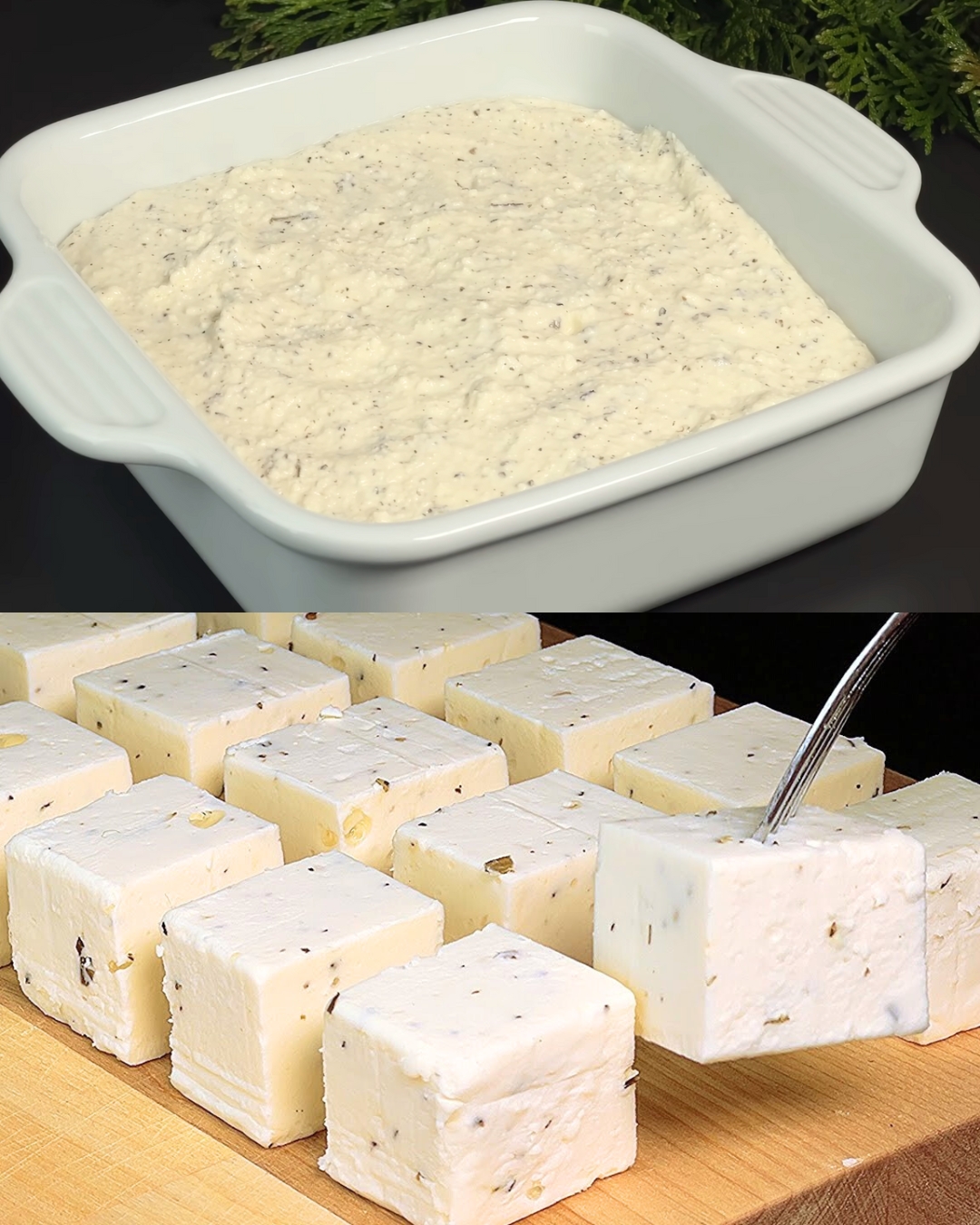This simple recipe for homemade fresh cheese uses milk, apple cider vinegar, and a few basic ingredients to create a delicious, creamy cheese. The addition of melted butter gives the cheese a rich texture, while the Provencal herbs (optional) add a fragrant, savory note. This fresh cheese is perfect for spreading on toast, adding to salads, or enjoying on its own.
Full Recipe:
Ingredients
- Milk: 1.5 liters (about 6 1/3 cups)
Whole milk is recommended for a creamier, richer cheese, but you can use lower-fat milk if preferred. - Apple cider vinegar: 2 tablespoons
This helps to curdle the milk, separating the curds from the whey. - Melted butter: 50 grams (about 3 1/2 tablespoons)
Adds richness and smoothness to the cheese, making it creamier. - Provencal herbs (optional): 1 tablespoon
A blend of dried herbs such as thyme, rosemary, and oregano adds a fragrant, savory flavor to the cheese. - Salt: to taste
Enhances the flavor of the cheese. Adjust the amount to your preference.
Instructions
Step 1: Prepare the Milk
- Heat the Milk: Pour the 1.5 liters of milk into a large pot. Heat it over medium heat, stirring occasionally to prevent the milk from scorching.
Heating the milk slowly and stirring regularly ensures an even temperature and prevents burning. - Monitor the Temperature: Heat the milk until it reaches a temperature of around 85°C (185°F). If you don’t have a thermometer, look for small bubbles forming around the edges of the pot, indicating the milk is hot enough.
Proper heating is crucial for the milk to curdle effectively when vinegar is added.
Step 2: Curds and Whey
- Add the Vinegar: Once the milk is heated, remove the pot from the heat. Slowly add 2 tablespoons of apple cider vinegar while stirring gently. You should start to see curds (solid chunks) forming and separating from the whey (liquid).
Adding vinegar causes the milk to curdle, separating into curds and whey. - Rest the Mixture: Let the mixture sit for about 5-10 minutes to allow the curds to fully form.
Allowing the curds to rest ensures they are fully separated and ready for straining.
Step 3: Strain the Curds
- Strain the Cheese: Line a colander or sieve with a clean cheesecloth or a thin kitchen towel. Pour the curdled milk mixture into the cloth, allowing the whey to drain away.
Straining removes the liquid whey, leaving behind the solid curds that will form the cheese. - Drain Excess Whey: Gather the corners of the cloth and gently squeeze to remove any remaining whey. Be careful not to squeeze too hard, as this can result in drier cheese.
Gentle squeezing ensures a smooth, creamy texture in the final cheese.
Step 4: Mix in Butter and Herbs
- Transfer to a Bowl: Place the drained curds into a mixing bowl. Add the 50 grams of melted butter, mixing it in thoroughly to create a creamy consistency.
Adding butter gives the cheese a smooth, rich texture. - Season the Cheese: Add salt to taste and, if desired, mix in 1 tablespoon of Provencal herbs for extra flavor.
Salt enhances the natural flavors of the cheese, while herbs add a savory touch.
Step 5: Shape and Chill
- Shape the Cheese: You can either press the cheese into a mold to shape it or leave it in the bowl for a more rustic look.
Shaping the cheese allows you to customize its appearance for serving. - Chill the Cheese: Cover the cheese and refrigerate for at least 1-2 hours to allow it to firm up.
Chilling helps the cheese set and improves its texture.
Step 6: Serve and Enjoy
- Serve: Once the cheese has chilled and firmed up, it’s ready to be served. Enjoy it spread on bread, crumbled over salads, or as a snack on its own.
Fresh cheese is versatile and can be used in a variety of dishes.
Nutritional Information (Approximate)
- Calories: 120-150 per serving (depending on portion size)
- Protein: 6-8g
- Fat: 10-12g
- Carbohydrates: 2-3g
- Calcium: High, due to the milk content
Tips for Success
- Use Whole Milk: Whole milk is recommended for a creamier texture, but you can experiment with other types of milk for different results.
- Adjust Salt: Start with a small amount of salt and adjust to taste, keeping in mind that some people prefer less salty cheese.
- Flavor Variations: Feel free to experiment with other herbs and spices to create different flavor profiles.
Frequently Asked Questions
- Can I use lemon juice instead of vinegar?
- Yes, lemon juice can be used as an alternative to apple cider vinegar to curdle the milk.
- How long will the cheese last?
- Homemade fresh cheese can be stored in the refrigerator for up to a week in an airtight container.
- Can I make this cheese dairy-free?
- Yes, you can try using non-dairy milk, such as almond or soy milk, though the texture and flavor may vary.
Conclusion
This homemade fresh cheese is a simple yet rewarding recipe that allows you to create delicious, creamy cheese with minimal ingredients. The addition of Provencal herbs provides a delightful flavor twist, making this cheese perfect for a variety of uses. Whether you enjoy it on its own, spread on toast, or as part of a dish, this fresh cheese is sure to become a favorite.

